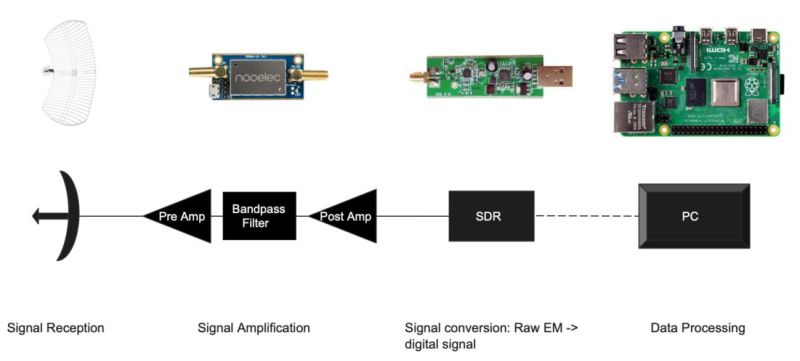What do you get when you put a one-meter parabolic dish, an SDR, a Raspberry Pi, and an H1-LNA for 21 cm emissions together? The answer is: a radio telescope that can track hydrogen in the Milky Way as well as the velocities of hydrogen clouds via their Doppler shifts, according to a paper by [Jack Phelps] titled “Galactic Neutral Hydrogen Structures Spectroscopy and Kinematics: Designing a Home Radio Telescope for 21 cm Emission“.
The hardware pipeline consists of three parts: antenna, signal conditioners, and computer, as per the above graphic by [Jack Phelps]. The solid lines are low-loss microwave coax LMR-400 cable, and the dotted line represents USB 3.0 between the RTL-SDR and Raspberry Pi 4 system. This Raspberry Pi 4 runs a pre-made OS image (NsfSdr) by [Dr. Glenn Langston] at the National Science Foundation, which contains scripts for hydrogen line observation, calibration and data processing.
After calibration, the findings were verified using publicly available data, and the setup could be used to detect hydrogen by pointing the antenna at the intended target in space. Although a one-meter parabolic dish isn’t going to give you the most sensitivity, it’s still pretty rad that using effectively all off-the-shelf components and freely available software, you too can have your own radio telescope.















I used to have a one meter for long distance wifi, shame I gave it away during a major move.
Reusing an abandoned Direct TV or other dish with such an amp and logger is something that I think about doing.
Is there a group who would designate a LatLong for me to monitor?
If you really want to go big, there are still abandoned 3 meter TV dishes out there, often free for hauling it off.
I keep on the lookout for one, but haven’t seen one yet.
Somewhere in the garage is a old LNB for one.
I did something similar with a Direct TV dish (but no doppler velocity). I spent ages trying to make helical antennas (which was kind of fun), but ended up getting the most success with a super simple dipole antenna. I would like to do it again, but with a symmetrical dish (hard to aim/focus the asymmetrical direct TV dishes).
The amplifiers in the diagram are backwards.
So they are sreifilpma instead?